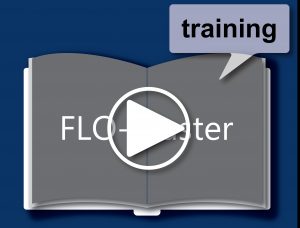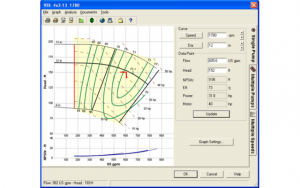Author: Engineered Software, Inc.
PIPE-FLO® Professional can be used to design new systems as well as to analyze existing ones. For the example HVAC system, we will quickly determine why we are not getting the required flow rates in the air handler loops and then try out a proposed solution to the problem. Also, using PIPE-FLO®’s pump sizing feature, we can determine if the existing pumps are oversized by calculating the actual total dynamic head (TDH) required for the system.
The system shown in Figure 1 below is an HVAC system that has not been operating properly. The flows through the air handler loops are less than required and there is excessive noise in the system. In order to determine what is causing these problems, we will first use PIPE-FLO® to analyze the existing configuration. Then, once we have found the reason behind the problems, we will use the program to test our proposed solution.
Existing System Analysis
The system model consists of the following:
- K values are used to model the chillers and air handlers.
- A Flow Control Valve is set at the required flow rate in each air handler loop (these are indicated in Figure 1).
- The pressure is set to 10 psig at the system expansion tank (located at node S2).
A calculation is performed for the existing system as described above. This calculation shows that the valve outlet pressures are all negative (approximately – 20 psig), as are the pressures at the pump suction nodes (approximately – 24 psig). Before such low pressures would be reached in the actual system, flashing across the valves and cavitation at the pumps would occur. The reduced capacity and excessive noise in this system are indicative of these problems. Also, the pressure drops across the Flow Control Valves are around 42 psi, which is too high for the particular model of valve that is being used. Instead we would like to see a pressure drop between 10 and 20 psi across these valves. However, before we address this problem, we will first eliminate the negative pressures in the system.
The Importance of Expansion Tank Location
The flashing and cavitation problems can be alleviated by reconsidering the location of the system expansion tank. First a quick review:
In a closed loop system, the expansion tank is the point of no pressure change in the system, it cannot be affected by the pump’s differential pressure. If you pump away from the expansion tank, the pump will add its differential pressure to the system’s fill (static) pressure. If you pump toward the expansion tank, the pump will remove its pressure differential from the static fill pressure. This is illustrated in Figure 2 below.
In the example, the static fill pressure of the system is 10 psig and the pump is capable of producing 20 psi of differential pressure. When the expansion tank is located at the pump’s suction (i.e. the pump is pumping away from the tank), the pressure at the pump discharge will be 30 psig. When the tank is located at the pump’s discharge (i.e. the pump is pumping right at the point where the tank is connected to the loop), the pump’s discharge pressure remains at 10 psig, but the suction side pressure drops to -10 psig. (Ref. D. Holohan, Teledyne Laars)
Watch this Video on Modeling a Multi-branch HVAC System in PIPE-FLO®
Moving the Expansion Tank
In the example system shown in Figure 1, the expansion tank is located at node S2. We will now reroute the piping so that the tank is connected to the system at the pump suction (node R5). Everything else in the system will remain the same. When we rerun the lineup calculation, the valve outlet pressures are now all positive (approximately 13 psig) as are the pump suction nodes (approximately 9 psig). Why does moving the expansion tank solve our low pressure problems? The way that this system is configured, the pump suction nodes are always going to be the point of lowest pressure in the system. By moving the expansion tank to node R5 (just upstream of the pumps’ suction nodes), we are in effect determining what the lowest pressure in our system will be.
Pumping Requirements
Even though we now have positive pressure readings throughout the system, the pressure drops across the Flow Control Valves are still too high (approximately 42 psi). These excessive pressure drops indicate that the existing pumps are oversized. The existing pumps are putting out a total dynamic head (TDH) of approximately 250 feet. To determine the TDH actually required for the system, we can use PIPE-FLO®’s pump sizing feature:
- Set the flow rate through each pump equal to the total system flow divided by three. Note that since this type of pump operation actually breaks the system where the pump is installed, we will have to leave an FCV out of the most hydraulically remote air handler loop in order to provide a path to all of the nodes in the system.
- Run the lineup and note the TDH calculated for the pumps. This is the TDH required for the system.
In our example HVAC system, the required TDH is determined to be approximately 160 feet and the pressure drops across the FCVs are all under 5 psi. Recall that we wanted a pressure drop across these valves between 10 to 20 psi. In order to have pressure drops in this range, we will have to increase the required pump TDH by about 23 feet (10 psi), giving a TDH of 183 feet.
Conclusion
This article has demonstrated PIPE-FLO®’s effectiveness as a troubleshooting tool for existing systems. For our example HVAC system, we were able to quickly determine why we were not getting the required flow rates in the air handler loops and then try out a proposed solution to this problem. Also, by using the pump sizing feature, we saw that the existing pumps were oversized and we determined the TDH actually required for the system.
 Download a free PIPE-FLO® Professional Demo.
Download a free PIPE-FLO® Professional Demo.




